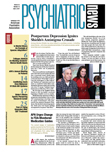An APA request that medication guides mandated by the Food and Drug Administration (FDA) list benefits of the medications, as well as the risks, was among the many views agency officials heard during public hearings in June on the pamphlets that accompany many psychotropic and other medications at the time they are dispensed.
The hearings in Washington, D.C., stemmed from an FDA decision to assess the effectiveness of and consider changes to the medication guides it has required pharmaceutical manufacturers to provide since 1998 for drugs that the FDA determines pose a “serious and signifi-cant public health concern.” The guides are intended to educate consumers about the medications' side effects and prevent serious adverse events.
It was initially estimated that the guides would be needed for about 1 million prescriptions annually, but that number has expanded to about 300 million prescriptions a year, covering 240 products.
Physicians in general and psychiatrists in particular have raised concerns that the guides' emphasis on the potential side effects of medications has dissuaded many patients from taking the medications. In the case of psychotropics, that aversion could lead to greater risks from untreated mental illness, APA has pointed out.
Darrel Regier, M.D., director of the American Psychiatric Institute for Research and Education and APA's Division of Research, testified that science-based guides can help patients better understand their prescribed medication, but information should be balanced to counter sensational media reports of medication dangers. The FDA, he said, should adopt standards that include the benefits of the drugs, in addition to potential side effects.
“The risks when the disorder is left untreated far outweigh the risks of treatment,” Regier said about depression medication.
Psychiatrists have urged the FDA to expand on a precedent-setting addition that the agency is requiring to the black box on antidepressant labeling warning about the suicidal risks of untreated depression, as well as the risks of the medication. No statement about the dangers of untreated depression in youth under age 18 appears in the current labeling, in effect since 2005. Manufacturers of antidepressants were asked to submit their updated labeling to the FDA last month (Psychiatric News, June 1).
David Fassler, M.D., a Vermont-based child and adolescent psychiatrist and an APA trustee-at-large, testified on behalf of the American Academy of Child and Adolescent Psychiatry (AACAP). He said that the black-box warnings have led to a big drop in antidepressant use among youth corresponding with an increase in youth suicides, according to recent data.
“While it is premature to draw definitive conclusions about causality, the implication is disturbing,” Fassler said.
The “disturbingly one-sided” guides emphasize risks and downplay benefits, while not providing adequate information to parents, he said. Fassler pointed out the benefits of well-designed guides and noted that APA and AACAP have developed an online supplemental guide to answer 14 common questions parents have about antidepressants.
Robert Temple, M.D., director of the Office of Medical Policy at the FDA's Center for Drug Evaluation and Research, questioned the feasibility of describing benefits in the guides because many psychotropics have never been researched to show comparative rates of suicidal behavior.
Although Fassler and other psychiatrists agreed that more research is needed on commonly used drugs to quantify their benefits, he noted some benefits that have already been shown, for example a 50 percent decrease in the suicide rate in teens taking lithium.
A factor complicating the labeling effort is that many of the benefits of medications are derived through broadly accepted uses that are off-label. The widely accepted suicide-prevention effect of lithium, for example, is an off-label use for depression treatment because none of its manufacturers has sought a labeling change to add an antidepressant indication.
Members of the FDA committee were urged to consider changes that could indicate the possibility of benefits beyond the specific approved uses for some drugs.
After testimony from psychiatrists, patient advocates, and pharmacist groups urging consumer-friendly redesigns, panel members voiced support for inclusion of a highlights section about the drug, followed by more details and a Web site consumers could visit for more information.
Many speakers also urged testing any redesigns of the densely worded guides on a broad spectrum of consumers to ensure that the language is accessible and intelligible to even below-average readers. However, FDA panel members said the urgency of the redesign would likely disallow much testing before distribution. Consumer testing could come after distribution, as part of future changes, Temple said.
Other common requests from speakers at the FDA hearings were that consumers have the option to receive the guides in electronic form and that federal officials standardize the format and length of the guides, which can be up to 30 pages long.
Although many representatives from pharmacies and drug makers urged the creation of a single guide to cover entire classes of drugs, others did not favor that idea. Carol Watkins, M.D., a psychiatrist and member of the board of directors of the Greater Baltimore chapter of Children and Adults With Attention-Deficit Disorder, said she prefers medication-specific guides because small differences between the drugs matter.
For example, “Some [medications have labeling that says] not to divide them, and others say to sprinkle them over food, and those details can make a big difference to patients,” Watkins said.
FDA information on the medication guides is posted at<www.fda.gov/cder/Offices/ODS/medication_guides.htm>. The APA and AACAP antidepressants guide is posted at<www.parentsmedguide.org>.▪
